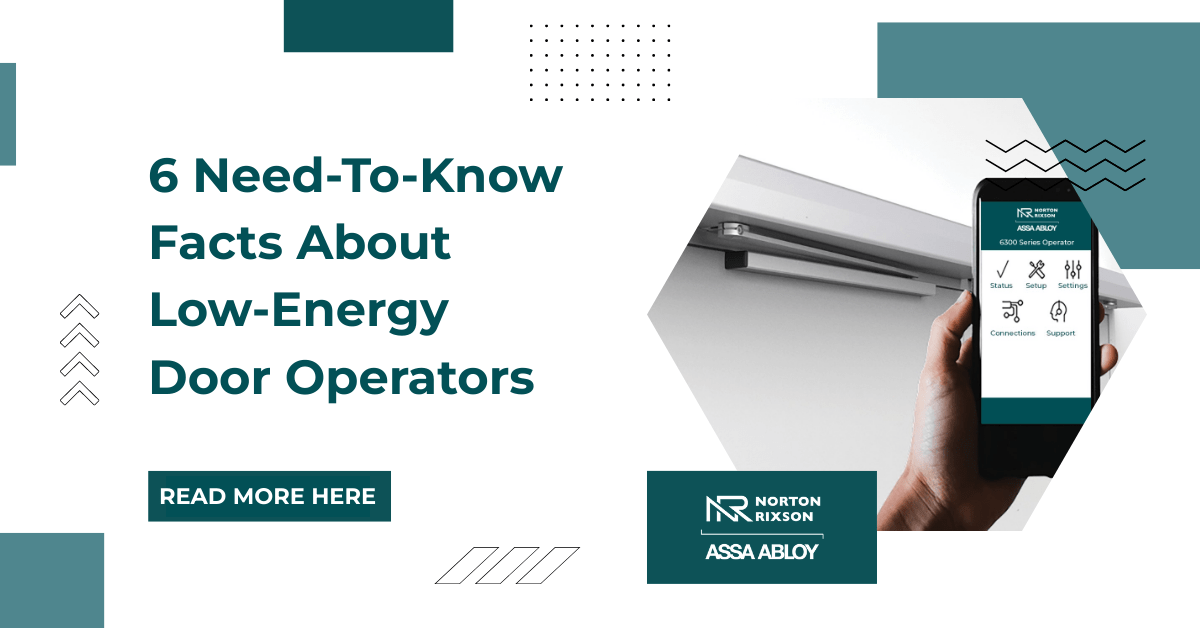6 Need-To-Know Facts About Low Energy Door Operators
Low energy door operators are designed to provide enhanced accessibility in commercial buildings. But where can they be installed, and are they ADA compliant? Learn the 6 essentials of low energy door operators here.

Low energy door operators improve accessibility. This helpful door control allows users of any mobility level to choose manual or automatic operation. Exterior and interior doors on a variety of buildings can benefit from this functionality.
These six facts cover the essentials of low energy door operators.
1) Low energy door operators and door closers are different
Closers and operators both support a door’s operation. Where they differ is which aspect of door operation they control.
Low energy door operators have a dual function – to assist with opening and closing doors. They completely power the door as it swings forwards and as it returns. The electronic operator is only activated when a user engages a push button, sensor, or wave-to-open switch.
Door closers have one purpose – to ensure that the door is fully closed. A person manually opens the door but the closer assists with latching. Common locations are theaters, hospitals, medical offices, and elementary schools. Door closers are mechanical and do not require any activation from the user.
2) Low energy door operators are installed on swinging doors
Operators are compatible with exterior entrances or interior openings; they can even be used on double doors. Low energy door operators are especially compatible with facilities that have high traffic or a population with limited mobility. Healthcare, schools, convention centers, retail, and government buildings are prime candidates for a low energy door operator.
Typical applications include:
- Main entrances
- Restrooms
- Reception rooms
- Laboratories
- Exam rooms
- Gymnasiums
- Conference rooms
Low energy door operators are also flexible because their opening force is adjustable. This allows architects and designers to account for factors such as the door’s weight and width, arm type, stack pressure, and wind.
3) Low energy door operators can be completely contactless
Sometimes a hands-free door is preferable. It’s an option that anyone using a mobility device, pushing a baby stroller, or walking with an armful of delivery packages can appreciate. As an added bonus, a touchless door minimizes germ transmission.
A touchless sensor can be synced to the low energy door operator. Choose from a wave-to-open switch, radio frequency device, push button, or remote control fob.
4) Low energy door operators comply with ADA
There are two standards that ensure a person with limited mobility can independently enter a building: ANSI/BHMA A156.19 for Power Assist and Low Energy Power Operated Doors and ICC A117.1 Accessible and Usable Buildings and Facilities. Low energy door operators satisfy a requirement in both called a “knowing act” – when a person can consciously choose to initiate a powered door opening.
5) Low energy door operators provide an emergency feature
Some door operators must have a “blow open” safeguard. This is a stipulation per NFPA 92B: Standard for Smoke Management Systems in Malls, Atria, and Large Spaces. If the fire or smoke alarm system is activated, the low energy door operator will automatically open to enable smoke ventilation. It then remains open until the alarm system turns off.
6) High energy door operators are a separate application
Energy refers to the amount of force needed by a human to move the door. This effort is different for every door, which is why door operators have high and low versions.
Low energy door operators are for swinging doors where manual operation is the default but there needs to be an automatic option. They are ideal for retrofits because there’s no need to change the door assembly or surrounding wall.
High energy door operators are for fully automated doors that slide or swing. These entrances need greater mechanical assistance because they are heavy, move rapidly, and open hundreds of times per day. A high energy operator is integrated with the entire door assembly, so it must be part of a new construction or renovation project.
Learn more in our post The Fundamental Difference Between Low and High Energy Door Operators.
Norton Rixson Low Energy Door Operators
We offer a portfolio of low energy door operators for a multitude of applications. Our 6000 Series and 6300 Series operators are heavy-duty units, with five additional options for light and moderate traffic. Intelligent functions include latch assist, obstruction detection, adjustable hold open delay, and access control integration. See which door operator is right for your next upgrade project by getting in touch with our team of experts today.